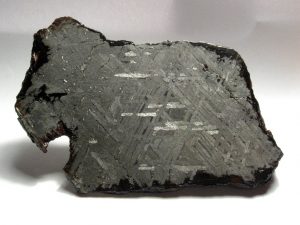Origin of the Universe: From Big Bang to Planet Earth
Charlene Estrada and Chris Johnson, Matthew D. Affolter, Paul Inkenbrandt, Cam Mosher
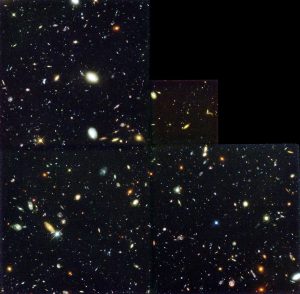
The universe appears to have an infinite number of galaxies and solar systems and our solar system occupies a small section of this vast entirety. The origins of the universe and solar system set the context for conceptualizing the Earth’s origin and early history.
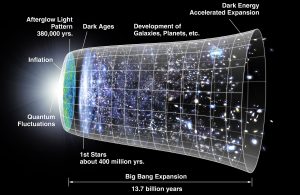
The mysterious details of events before and during the universe’s origin are subject to great scientific debate. The prevailing idea about how the universe was created is called the big-bang theory. Although the ideas behind the big-bang theory feel almost mystical, they are supported by Einstein’s theory of general relativity. Other scientific evidence, grounded in empirical observations, supports the big-bang theory. The big-bang theory proposes that the universe was formed from an infinitely dense and hot material core. The bang in the title suggests there was an explosive, outward expansion of all matter and space that created atoms. Spectroscopy confirms that hydrogen makes up about 74% of all matter in the universe. Since its creation, the universe has been expanding for 13.8 billion years, and recent observations suggest that this expansion is increasing.
COSMIC MICROWAVE BACKGROUND RADIATION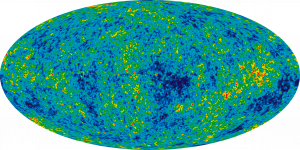
A strong indication of the big bang is cosmic microwave background radiation. Cosmic radiation was accidentally discovered by Arno Penzias (1933–) and Robert Woodrow Wilson (1936–) when they were trying to eliminate background noise from a communication satellite. They discovered very faint traces of energy or heat that are omnipresent across the universe. This energy was left behind from the big bang, like an echo.
Stellar Evolution
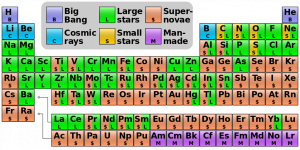
Astronomers think the big bang created lighter elements, mostly hydrogen, and smaller amounts of elements helium, lithium, and beryllium. Another process must be responsible for creating the other 90 heavier elements. The current model of stellar evolution explains the origins of these heavier elements.
BIRTH OF A STAR
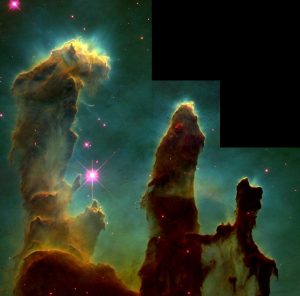
Stars start their lives as elements floating in cold, spinning clouds of gas and dust known as nebulas. Gravitational attraction or perhaps a nearby stellar explosion causes the elements to condense and spin into a disk shape. In the center of this disk shape, a new star is born under the force of gravity. The spinning whirlpool concentrates material in the center, and the increasing gravitational forces collect even more mass. Eventually, the immensely concentrated mass of material reaches a critical point of such intense heat and pressure it initiates fusion.
Origin of the Solar System: The Nebular Hypothesis
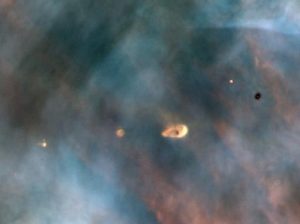
Our solar system formed at the same time as our Sun, as described in the nebular hypothesis. The nebular hypothesis is the idea that a spinning cloud of dust made of mostly light elements, called a nebula, flattened into a protoplanetary disk and became a solar system consisting of a star with orbiting planets. The spinning nebula collected the vast majority of material in its center, which is why the sun Accounts for over 99% of the mass in our solar system.
Planet Arrangement and Segregation
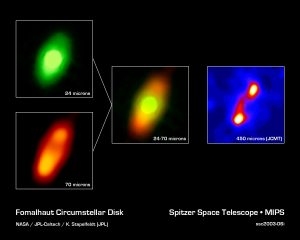
As our solar system formed, the nebular cloud of dispersed particles developed distinct temperature zones. Temperatures were very high close to the center, only allowing condensation of metals and silicate minerals with high melting points. Farther from the Sun, the temperatures were lower, allowing lighter gaseous molecules such as methane, ammonia, carbon dioxide, and water condensation. This temperature differentiation resulted in the inner four planets of the solar system becoming rocky, and the outer four planets becoming gas giants.

Both rocky and gaseous planets have a similar growth model. Particles of dust, floating in the disc were attracted to each other by static charges and eventually, gravity. As the clumps of dust became bigger, they interacted with each other—colliding, sticking, and forming proto-planets. The planets continued to grow over the course of many thousands or millions of years, as material from the protoplanetary disc was added. Both rocky and gaseous planets started with a solid core. Rocky planets built more rock on that core, while gas planets added gas and ice. Ice giants formed later and on the furthest edges of the disc, accumulating less gas and more ice. That is why the gas-giant planets Jupiter and Saturn are composed of mostly hydrogen and helium gas, more than 90%. The ice giants Uranus and Neptune are composed of mostly methane ices and only about 20% hydrogen and helium gases.
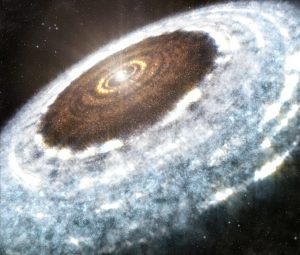
This artist’s impression of the water snowline around the young star V883 Orionis, as detected with ALMA.
The planetary composition of the gas giants is clearly different from the rocky planets. Their size is also dramatically different for two reasons: First, the original planetary nebula contained more gases and ices than metals and rocks. There was abundant hydrogen, carbon, oxygen, nitrogen, and less silicon and iron, giving the outer planets more building material. Second, the stronger gravitational pull of these giant planets allowed them to collect large quantities of hydrogen and helium, which could not be collected by the weaker gravity of the smaller planets.
